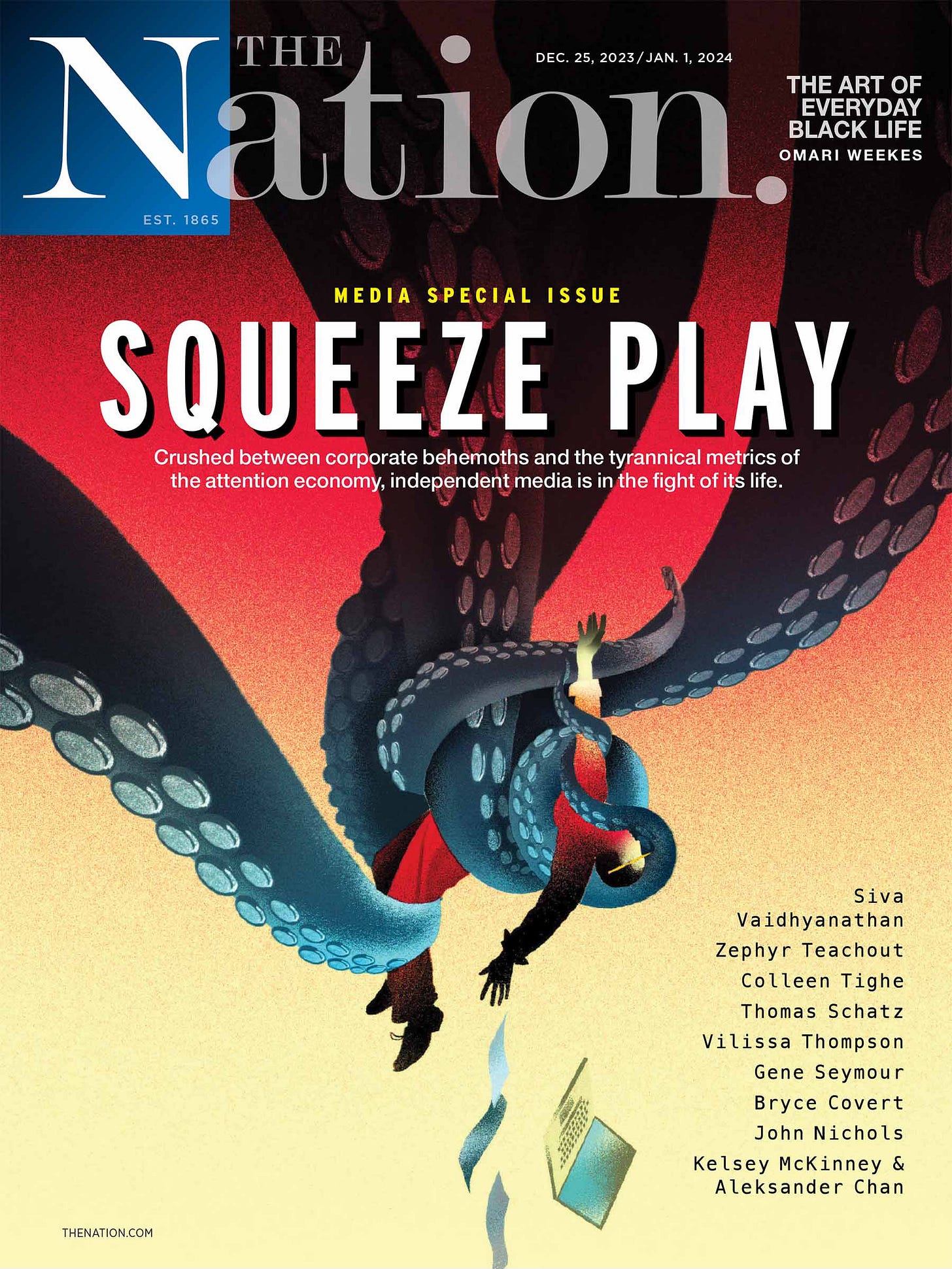Here we go! We’re kind of committed to 2024 now. I hope each and every one of you had a great holiday break, enjoyed Christmas or Kwanza or Chanukah and New Years. If you made some resolutions, I hope that it is all going well for you.
I’m really bad at New Years’ resolutions. That’s not because I don’t want to keep a promise to myself or my family. In my experience, life is pretty random and it feels to me like the best laid plans frequently go far afield. So make plans, but be prepared to pivot. I don’t want to be so rigid in my personal or professional life that I can never adjust to a new reality. So I personally believe that it’s best to have a plan, and plan for that plan to not entirely work out as planned. And plan to not get too exercised when things go off in a different direction.
Which they often do.
I often say that long as there is no major arterial bleeding, we’re good.
This is supposed to be a newsletter about life in the world of magazine media and for the most part it is. Newsletters are a part of what every single publisher I work with now produces along with the print and digital variants of their magazines. And here in this new post-pandemic world, publishers are creating all sorts of offerings for their readers. So it makes sense for me to deliver something to the newsletter world. It gives me a voice, a seat at the table, and I enjoy the discipline of trying to plan and find things that I think will be of use to my readers.
Two and a half years and 118 editions ago, I started this newsletter on the Revue platform on Twitter. I liked its ease of use, the fact that I didn’t have to mess around with much of anything. At the time, while Twitter was problematic, it was still a relatively decent place. Then Revue went away and some other things happened (Hi Elon!) and I moved here, to Substack. Staying here was fine until it was pointed out to me that there were writers on the platform who were clearly anti-semites, and/or racists, or anti LGBTQ, and for some reason the founders weren’t interested in doing much about that.
I’ve stayed on the platform (for now) for several reasons: The first is simply that as a freelancer/permalancer, there’s only so much bandwidth for this newsletter. Platforms like Substack (and at one time Revue) are a good way to go, especially if I wanted to see my audience grow. I had previously blogged on Wordpress and worked Twitter pretty hard. While all of that was fun, it was clear after a while that I was talking to only a few other people with little engagement. On Substack my audience significantly larger and engagement is almost worthwhile.
The second reason is that this is not the first time in my life I’ve encountered Neo-Nazis, anti-semites, blatant racists, folks bent on mindlessly hating the LGBTQ. You kind of have to grow a thick skin, tell yourself in the back of your mind that “Yes, it can happen here.”
But now it appears that there may be more than just a “bit” of a problem with Neo-Nazis, racists, white supremacists, anti-semites and anti-LGBTQ writers on the platform and some independent journalists have forced the hand of the creators of Substack and have asked them to address things.
An Atlantic Monthly article by Substacker Jonathan Katz published some articles about the Neo-Nazi Substackers and that led to a campaign by some Substack writers to try and get a response from the creators of the platform.
Here’s a link to the letter that was sent. Yes, I signed it.
Not surprisingly, the founders responded and said that they don’t like Nazis either, but they don’t plan on moderating anything they write. And, they’re perfectly fine on taking their 10% cut of their subscribers.
I get it. I get the desire to not censor speech. But if often seems to me that these advocates of free speech (Are they also the same guys who will turn to you and say, “Well, actually, in the time of the Roman Republic…”) are conflating the First Amendment with private speech? These are two entirely different things. Social media platforms are not government agencies and they’re not subject to the First Amendment. And I think it’s pretty easy to draw a direct line from the growth of national AM talk radio through to the growth of cable news, to the growth of social media platforms to the growth of disinformation, misinformation, to troll farms to the giant honking cracked up nonsensical partisan world we now live.
Now, with Neo-Nazis!
I’ll repeat myself until I am blue in the face: If you own a platform that people put content on, it’s not just a street corner with people standing on street corners screeching at each other. Congratulations, you’re a publisher. You’re responsible for what is going out into the world. You need to monitor that. Sometimes you will get it right. Sometimes you will screw up. It will cost your organization money and that will drive your financial guys crazy.
F*ck the financial guys.
Do what is right. Moderate your content. What am I going to do? I don’t know just yet. A lot of us don’t know just yet. So stay tuned.

One__Another way to think about AI…
Just before the end of the year, news broke that a series of articles that appeared on the Sports Illustrated site were written by AI bots but presented as written by actual journalists. Of course this wasn’t the case and after some back and forth and some corporate “This is not who we are” statements, the AI generated gunk got taken down.
Washington Post Journalist Josh Tyrangiel posits that while, yes, what Sports Illustrated did was pretty terrible, it does offer us an opportunity to think about the use of AI in journalism in a different way. He points out:
To the outside world, the difference between a background actor (formerly known as extras) and a person with spare time and a face is hard to understand. But the Screen Actors Guild decided background actors are skilled craftspeople, and its members fought hard to get them protections from being made obsolete by AI. The SAG had unique leverage in its last negotiation, but will law firms stick together when AI proves adept at low-level functions such as filling out personal injury demand letters? Will radiologists who map out complicated cancer treatments stand by their X-ray-reader colleagues when AI can diagnose a break faster and better? If we try to defend everything about the status quo, we’re guaranteed to lose.
Very true. AI can free us up from some mundane tasks. I guess my issue remains that unless we have some solid guardrails in place, there will be more than a few operations willing to push the margins in favor of profits.
two__The Nation moves from bi-weekly to monthly. This makes sense
This is a magazine that does not rely on print or even digital advertising. Their primary source of funds are donations, memberships and subscriptions to the magazine. News and opinions are now easily acquired on line so the chance to get a monthly magazine that is twice the size of the current biweekly and offers a curation of ideas, opinions and news is a great idea.
three__Mr Magazine names the “Launch of the Year 2023” Plus the 10 most notable launches of last year
If you work in magazine media, there’s an excellent chance that you already know all about Mr. Magazine, Samir Husni, the former Ole Miss professor of journalism (now retired). His website, Mr. Magazine is chock full of fascinating interviews and lists of new title launches.
For 2023 he named TV Insider as the launch of the year and I have to heartily agree. The publication is well laid out, colorful, and does exactly what it is supposed to do for its readership. It tells you what you want to know about TV shows, where to find them, the actors in them, and what the latest news is.
Check out his list of notable launches. My personal favorite has to be Trails Magazine.
four__Pivot Fund to map indie news sites in Great Lakes region
The Pivot Fund has dedicated $500million to invest in local news organizations over the next five years. They’ve already identified and will be giving grants to seven news orgs in Georgia that serve Black, Hispanic and Asian-American audiences.
As a resident of flyover country, I can attest to the sad lack of local news orgs. The zombified remains of the Chicago Tribune, Sun-Times and local Pioneer Press barely cover anything in Chicago or the surrounding suburbs. A few daily suburban newspapers run mostly syndicated news or cover a few local sports. I’ve found a few online news sites, but like the local TV news broadcasts, they’re mostly interested in violent murders, car crashes and the occasionally corrupt politician.
What I like about this “mapping” is that they’ll be looking for, identifying, and then hopefully supporting, news orgs that are reaching people where they are. As the press release states:
Most of these sites didn’t look like traditional news organizations because they publish primarily on social media, particularly Facebook, Instagram and TikTok. Yet that reflects a fundamental shift in news consumption by young people and communities of color. The Pivot Fund starts by asking communities what sources they trust for news and information, no matter the platform, and then verifies that they adhere to journalistic ethics and standards.
five__Opinion: Alex Mahadevan on AI and X
Let’s wrap this all up with Poynter MediaWise director Alex Mahadevan on the rise of generative AI, his hopes for 2024 election information and the potential demise of X, the platform formerly known as Twitter.
Mahadevan makes a case that newsrooms and fact checkers should embrace the AI tools that are available to them and use them to combat misinformation and disinformation.
He also discusses that while Community Notes on X works relatively well in some cases, it does not scale.
Finally, if you’re finding yourself confused about the scope of misinformation about the war between Israel and Hamas, check out this excellent guide from Mahadevan about how to avoid misinformation and some easy steps you can take to tell if what you’re reading is real or not.
Your Moment of Magazine Zen…

I hope you enjoyed this newsletter. Please “Like” and subscribe. You’ll get a brand new release in your email in-box every Tuesday (Or sometimes Wednesday, if things get a little hectic around here).
Want to find me on the social sites?
My Instagram link is here.
I’m now hanging out at Post.News and you can find me here on their app.
Every now and then I get to put on a suit and tie and comb my hair. Here’s my LinkedIn profile if you want to see me looking all professional.
So I’ve sort of, kind of committed to testing the waters at BlueSky. I’m not sure how I feel about it all but if you’re there want want to look me up, here’s where you might find me…
That’s all I got for you this week. I hope this newsletter finds you well and having survived not only the New Years’ break, but also the brand new year at the office (or home office). May your work week be tolerable, your in-box manageable, and may we soon abandon the desire to have all uniform backgrounds on our Zoom-Meet-Teams calls. C’mon boss man, let us have some fun!







